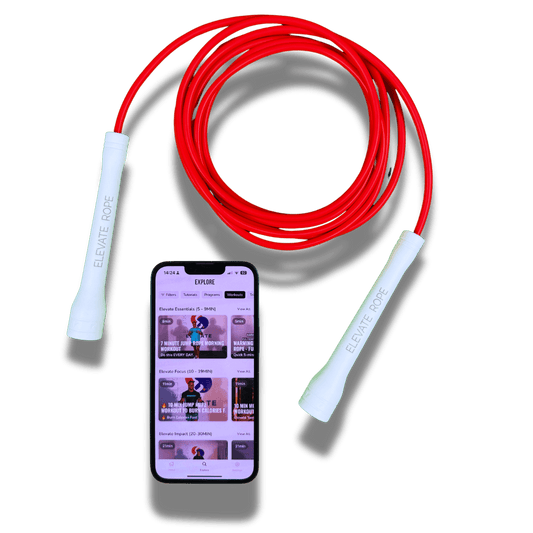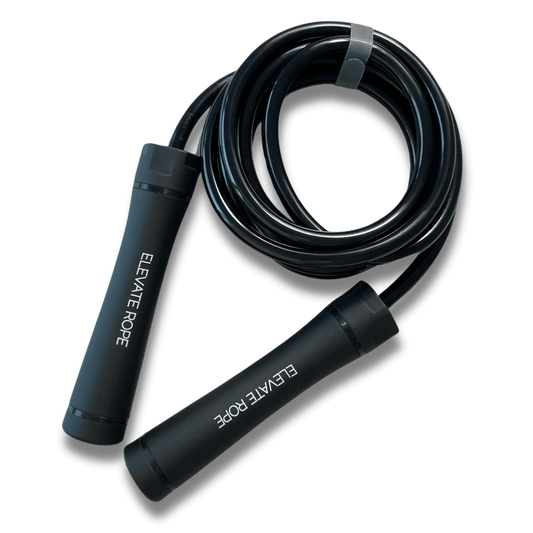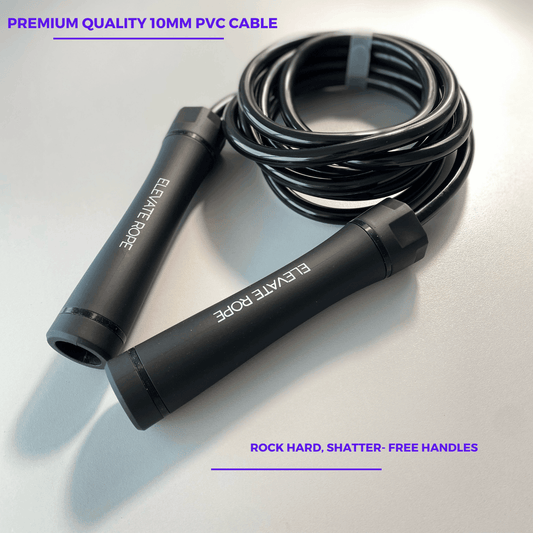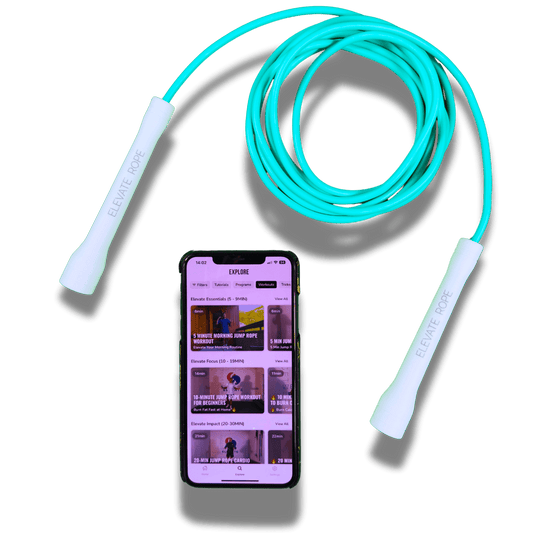Why commit to hours at the gym when a simple jump rope can unlock six completely different training styles? From explosive HIIT sessions to stamina-building endurance, from freestyle creativity to fighter footwork, the rope adapts to every fitness goal. It’s portable, affordable, and versatile enough to deliver fat-burning cardio, full-body strength, and even skill-based training—all with one piece of equipment that fits in your backpack.
This guide is your roadmap to the many faces of jump rope training. Whether you’re chasing fast calorie burn, building power with heavy ropes, or flowing through freestyle combos, you’ll find a method that matches your personality, goals, and schedule. Each section dives deep into a unique style, complete with workout examples, pro tips, and the rope recommendations that make training more effective.

1. HIIT Jump Rope Workouts: 10, 15 & 20 Minute Templates
High-Intensity Interval Training (HIIT) has become one of the most effective ways to burn fat, build endurance, and maximize results in less time. The idea is simple: push your body with short bursts of all-out effort, followed by brief recovery periods. This cycle of work and rest keeps your heart rate elevated, increases your metabolism, and continues burning calories even after the workout ends.
Why Jump Rope Is Perfect for HIIT
Jump rope is practically built for HIIT. Every swing demands speed, rhythm, and full-body engagement. Unlike running or cycling, it recruits both your upper and lower body at once—delivering more calorie burn in less time.
- Burns up to 16 calories per minute depending on intensity and body weight.
- Easy to scale: adjust rope speed, footwork, or intervals.
- Portable: you can do it anywhere, no gym required.
- Fun and varied: switch tricks mid-workout to stay engaged.
That’s why jump rope HIIT is a go-to method for athletes, fighters, and fitness beginners alike. Whether you only have 10 minutes or want a full 20-minute sweat, the following templates are plug-and-play.
🔥 10-Minute Fat-Burner
Perfect for busy mornings or a quick lunchtime reset.
| Round | Exercise | Work | Rest |
| 1 | Basic bounce | 40 sec | 20 sec |
| 2 | High knees | 40 sec | 20 sec |
| 3 | Side-to-side jump | 40 sec | 20 sec |
| 4 | Rest | — | 60 sec |
| Repeat 2x | — | — | — |
Total time: ~10 minutes
Calories burned: ~120–150
⚡ 15-Minute HIIT Routine
A balanced session for fat loss and endurance.
| Round | Exercise | Work | Rest |
| 1 | Basic bounce | 45 sec | 15 sec |
| 2 | Double unders | 30 sec | 30 sec |
| 3 | Boxer step | 45 sec | 15 sec |
| 4 | Rest | — | 60 sec |
| Repeat 3x | — | — | — |
Total time: ~15 minutes
Calories burned: ~180–220
🔥💪 20-Minute Full-Body Torch
Push your limits with this advanced finisher.
| Round | Exercise | Work | Rest |
| 1 | Basic bounce + crossovers | 40 sec | 20 sec |
| 2 | High knees | 45 sec | 15 sec |
| 3 | Push-up burpee + 10 rope jumps | — | 30 sec rest after each set |
| 4 | Double unders | 30 sec | 30 sec |
| 5 | Rest | — | 90 sec |
| Repeat 3x | — | — | — |
Total time: ~20 minutes
Calories burned: 250+
Pro Tip: Use RPE (Rate of Perceived Exertion)
On a scale of 1–10, aim for:
- 8–9 during work intervals (breathing hard, can’t hold a conversation).
- 4–5 during rest (catching breath but still moving).
This ensures you’re pushing hard enough to maximize HIIT benefits without overtraining.
👉 Want to make your HIIT more effective? The Speed Rope is perfect for fast-paced intervals and double unders, while the Max Bundle gives you multiple ropes to switch intensity and style.
[Shop the Speed Rope / Max Bundle →]

2. Endurance Training with Jump Rope: Build Stamina in 30 Days
Endurance isn’t built overnight—it’s a gradual process of training your body to perform longer, harder, and more efficiently. Jump rope is one of the most effective tools for this because it strengthens your aerobic system, challenges your cardiovascular endurance, and recruits multiple muscle groups at once. Just like running or cycling, consistent jump rope practice boosts your VO₂ max (your body’s ability to use oxygen during exercise), but with the added benefits of agility, coordination, and calorie burn.
The key to improving stamina is progressive overload—gradually increasing time, intensity, or complexity. With jump rope, this might mean starting with steady 5-minute sessions and building up to longer, more varied workouts over four weeks.
Why Jump Rope Works for Endurance
- Engages both aerobic and anaerobic systems.
- Teaches rhythm and breathing control.
- Builds lower-body durability without the same impact as running.
- Scales easily—simply extend intervals or add footwork patterns.
30-Day Endurance Plan
Here’s a sample progression to build stamina step by step:
Week 1: Foundation (10 minutes daily)
- 1 min basic bounce, 30 sec rest × 8 rounds.
- Focus on relaxed rhythm and breathing.
Week 2: Expansion (12–14 minutes)
- 90 sec basic bounce, 30 sec boxer step × 6 rounds.
- Introduce variety while keeping volume manageable.
Week 3: Conditioning (15–18 minutes)
- 2 min boxer step, 1 min side-to-side, 30 sec rest × 5 rounds.
- Build continuous movement with minimal recovery.
Week 4: Endurance Peak (20 minutes+)
- 3 min basic bounce, 2 min boxer step, 1 min double unders, 1 min rest × 4 rounds.
- Push to longer intervals, simulate race-style stamina.
Pro Tips for Building Stamina
- Focus on rhythm over speed in the early weeks.
- Breathe consistently: inhale through the nose, exhale through the mouth.
- Add time in small increments (1–2 minutes per session).
- Stay consistent—endurance gains come from steady practice, not intensity spikes.
👉 Ready to put this into practice?
- Beginners: Start with the Ascent Bundle, designed to make rhythm and basics effortless.
- Intermediates: Upgrade to the Max Bundle, giving you multiple ropes to challenge stamina at different intensities.
[Shop the Ascent Bundle / Max Bundle →]
3. Strength Training with Heavy Ropes: Full-Body Power in 15 Minutes
When most people think of jump rope, they picture speed and cardio. But add extra weight to the rope, and suddenly you’ve got a strength and conditioning powerhouse in your hands. Heavy ropes (often weighing ½ lb to 2 lbs) force your muscles to work harder with every rotation, turning each session into a full-body workout.
Unlike traditional strength training with dumbbells, heavy rope skipping combines strength, cardio, and coordination in one. Your shoulders, forearms, core, and legs are constantly under tension, while your cardiovascular system fights to keep up. The result: improved muscle endurance, explosive power, and calorie burn that rivals HIIT workouts.
Why Train with Heavy Ropes?
- Upper-Body Strength: Shoulders, traps, and arms must control each swing.
- Core Engagement: The extra load stabilizes your midsection every jump.
- Explosive Power: Builds fast-twitch muscle fibers for athletes and fighters.
- Conditioning + Strength: Burns fat while building muscular endurance.
Even 10–15 minutes with a heavy rope is enough to leave your entire body fatigued.
Tips for Success with Heavy Ropes
- Start Small: Begin with a ½ lb rope before moving up in weight.
- Form First: Keep shoulders relaxed and elbows tucked to avoid strain.
- Mix with Bodyweight: Alternate rope intervals with push-ups, squats, or planks for a full-body burn.
- Limit Frequency: 2–3 sessions per week is ideal to allow muscle recovery.
Who Should Use Heavy Ropes?
- Athletes looking to build power, explosiveness, and conditioning.
- Fitness enthusiasts wanting strength + cardio in one short session.
- Intermediate/advanced jumpers who want a new challenge.
Beginners should focus first on rhythm and endurance with lighter ropes before adding weight.
👉 Want to feel the burn for yourself? Upgrade to the Elevate Heavy Rope (part of the Athlete Bundle) and unlock your strength potential in just 15 minutes a day.

4. Freestyle Jump Rope for Flow & Creativity: Step-by-Step Guide to Combos
Jump rope isn’t just about burning calories — it’s also a form of movement art. Freestyle skipping transforms training into self-expression, combining rhythm, coordination, and creativity into a flow that feels more like dance than exercise. With the right rope and a bit of guidance, anyone can unlock freestyle skills and build confidence through movement.
Why Freestyle Training Matters
- Mind-Body Connection: Every release, crossover, or footwork pattern sharpens timing and coordination.
- Creativity & Flow: Combos allow you to string skills together like choreography.
- Engagement: Freestyle keeps workouts fresh — no two sessions need to look the same.
- Community & Performance: Freestyle skills are popular for sharing online, inspiring others, and joining the global jump rope movement.
For freestyle, the beaded rope or long-handle rope is your best tool. Beads give rhythm and feedback, while long handles make releases smoother and easier to control.
Step-by-Step Progression into Freestyle
Step 1: Master the Basics Before you dive into tricks, build a foundation with the boxer step, side swings, and crossovers. These moves teach rhythm and rope control.
Step 2: Add Simple Tricks
Introduce single cross, side swing open, or EB (underarm cross). Start slow and focus on clean timing.
Step 3: Learn Releases
Practice underhand throws and catch drills with a long-handle rope. Releases add flair and flow to your combos.
Step 4: Build Combos
Link tricks together. Example: Side swing → Crossover → Double under → Release → Catch. Practice at half speed before going full flow.
Step 5: Flow Training Turn combos into routines. Set a timer (e.g., 30 seconds) and try to keep the rope moving without stopping, mixing tricks naturally.
Example: Beginner Freestyle Combo
- Side swing →
- Open basic bounce →
- Cross over →
- Side swing →
- Boxer step
Repeat sequence until it feels smooth.
Tips to Unlock Freestyle Flow
- Film Yourself: Watching playback helps spot mistakes and track progress.
- Train in Intervals: 30–45 sec freestyle → 15 sec rest → repeat for 8–10 rounds.
- Play with Music: Syncing to beats makes freestyle more natural and fun.
- Celebrate Small Wins: Every trick landed is progress.
Who Should Try Freestyle?
- Beginners wanting to make workouts more fun.
- Intermediates looking to expand their skill set.
- Advanced jumpers chasing flow state and performance.
Freestyle isn’t about perfection — it’s about expression. Once you feel the rope moving with you instead of against you, you’ll unlock a level of enjoyment that makes consistency effortless.
👉 Ready to take your flow to the next level? Check out the Elevate Beaded Rope or Long Handle Rope — designed specifically for freestyle and creative training.
📌 CTA: [Shop Freestyle Ropes →]
5. Boxing Jump Rope Drills: Footwork, Agility & Conditioning for Fighters
If you’ve ever watched a boxer train, you’ve likely seen them with a rope in hand. Jump rope has been a staple of fight prep for decades — and for good reason. It develops the speed, agility, and endurance that fighters rely on inside the ring. But you don’t need to be a pro to benefit. Whether you’re training for boxing, MMA, or just want to move like an athlete, boxing-style jump rope drills are one of the best ways to sharpen your body and mind.

Why Jump Rope Is Essential for Fighters
- Footwork Mastery: Staying light on your feet allows quick pivots, lateral movement, and explosive reactions.
- Agility & Balance: The constant rhythm of the rope teaches coordination and stability under pressure.
- Endurance Conditioning: Rounds of skipping build the same stamina fighters need to maintain intensity across multiple rounds.
- Timing & Rhythm: Rope rhythm translates to fight rhythm, improving reaction time between offense and defense.
Key Boxing Jump Rope Techniques
1. The Boxer Step
The classic. Shift weight side to side as you skip, mimicking in-ring footwork. Builds endurance without heavy impact.
2. Side Swings Swing the rope at your sides for a beat, then jump. Great for active recovery between high-intensity bursts.
3. Double Unders The rope passes twice per jump. Perfect for building explosive power and fight-ready conditioning.
4. Forward & Backward Skips
Move forward and back with small hops while skipping. Reinforces mobility and quick directional changes.
5. High-Knee Skips
Drive knees upward while jumping, simulating fight intensity and strengthening your core.
Example: Fighter’s 3-Round Jump Rope Circuit
Round 1 – Warm-Up (3 min)
- 60 sec boxer step
- 30 sec side swings
- 30 sec basic bounce
- Repeat sequence
Round 2 – Conditioning (3 min)
- 20 sec double unders
- 40 sec boxer step
- 20 sec high-knee skips
- 40 sec basic bounce
- Repeat until time’s up
Round 3 – Agility & Reaction (3 min)
- 20 sec forward skips
- 20 sec backward skips
- 20 sec side-to-side hops
- 60 sec boxer step
- Repeat sequence
Rest 1 minute between rounds, just like in boxing.
Tips for Boxing-Style Training
- Use a Speed Rope: Lightweight and fast, it matches the pace fighters need.
- Train in Rounds: Structure sessions in 3-minute rounds with 1-minute rests to simulate fight conditions.
- Stay Relaxed: Keep shoulders loose and hands slightly forward, mimicking guard position.
- Mix It Up: Alternate between slow rhythm, agility drills, and explosive bursts to mimic fight tempo.
Who Benefits Most?
- Fighters (boxing, MMA, kickboxing) looking for sharper footwork and conditioning.
- Athletes in other sports who need agility and endurance.
- Everyday jumpers who want to train like fighters for intensity and variety.
👉 Want to train like the pros? Grab the Elevate Speed Rope or Max Bundle — built for speed, agility, and explosive conditioning.
6. Jump Rope Circuit Workouts: Combine Ropes with Bodyweight Training
Jump rope alone is already one of the most effective calorie-burning workouts you can do. But when you combine it with bodyweight strength moves like push-ups, squats, and burpees, you create a circuit that pushes both your cardiovascular system and your muscles to the limit. This hybrid style of training is perfect for anyone who wants full-body conditioning, functional strength, and serious fat loss — all without a gym.
The magic of circuit training lies in the variety. By alternating between rope intervals and strength exercises, you keep your heart rate high while targeting different muscle groups. That means more calories burned, better endurance, and a workout that feels challenging yet never boring. Circuits are also highly scalable — shorten the rounds for beginners, extend them for advanced athletes, and mix in freestyle jump rope skills to keep things fun.
Benefits of Jump Rope Circuits
- Double Impact: Combine cardio + strength for maximum calorie burn and muscle tone.
- Efficiency: Full-body training in 20–30 minutes — no machines required.
- Scalability: Adjust intensity by swapping ropes (speed, heavy, beaded) or bodyweight moves.
- Engagement: Constantly changing exercises prevent monotony and keep motivation high.
Example Full-Body Circuit (5 Rounds)
Round 1: Warm-Up (2 minutes)
- 30 sec basic bounce
- 30 sec boxer step
- 30 sec side swings
- 30 sec push-ups (steady pace)
Round 2: Lower Body + Cardio (4 minutes)
- 45 sec jump rope (double unders or speed skips)
- 15 sec rest
- 15 squats (bodyweight or jump squats)
- Repeat sequence 3 times
Round 3: Upper Body + Core (4 minutes)
- 45 sec beaded rope freestyle / side swings
- 15 sec rest
- 12 push-ups + 20 mountain climbers
- Repeat sequence 3 times
Round 4: Power & Explosiveness (4 minutes)
- 30 sec heavy rope basic bounce
- 30 sec burpees
- 30 sec high-knee skips
- 30 sec rest
- Repeat sequence twice
Round 5: Finisher (3 minutes)
- 20 sec speed rope double unders
- 10 sec rest
- 20 sec plank-to-push-up
- 10 sec rest
- Repeat sequence until time is up
Total time: ≈20–25 minutes, scalable for all levels.
Tips for Circuit Success
- Rotate rope types: Use speed ropes for cardio bursts, heavy ropes for power, and beaded ropes for freestyle.
- Keep transitions short (10–15 seconds) to maintain intensity.
- Aim for 2–3 circuits per week as a supplement to your regular training.
- Track progress by increasing reps, reducing rest, or adding new freestyle combos.
👉 Want the best setup for hybrid training? The Elevate Athlete Bundle gives you every rope type in one kit — speed for cardio, heavy for strength, and long-handle/beaded for freestyle. Perfect for circuit athletes who want it all.
Conclusion: Find Your Training Style, Unlock Your Potential
From high-intensity HIIT to stamina-building endurance, from explosive strength with heavy ropes to creative freestyle flows — jump rope is more than just one workout. It’s six unique training styles that adapt to your goals, your personality, and your lifestyle. That’s why athletes, fighters, and everyday movers alike keep coming back to the rope: it delivers versatility, results, and fun all in one.
By exploring each style, you’ve seen how:
- HIIT jump rope workouts torch calories in minutes.
- Endurance training builds lasting stamina and lung power.
- Heavy ropes develop functional strength and conditioning.
- Freestyle flows keep you creative and consistent.
- Boxing drills sharpen agility, timing, and athletic movement.
- Circuit training combines cardio and strength for full-body results.
The best part? You don’t have to choose just one. With the right set of ropes, you can rotate between training styles — keeping your workouts fresh, your body challenged, and your progress unstoppable.
That’s why we designed the Elevate Bundles. Each one gives you the exact ropes you need for your preferred style — or for mixing them all together:
- Ascent Bundle: Perfect for beginners building their foundation.
- Max Bundle: For those ready to push further with speed and variety.
- Athlete Bundle: The ultimate all-in-one set for strength, freestyle, and everything in between.
👉 Your next step is simple: choose the bundle that matches your goals, start your first session, and experience how one rope can unlock six powerful training styles.














